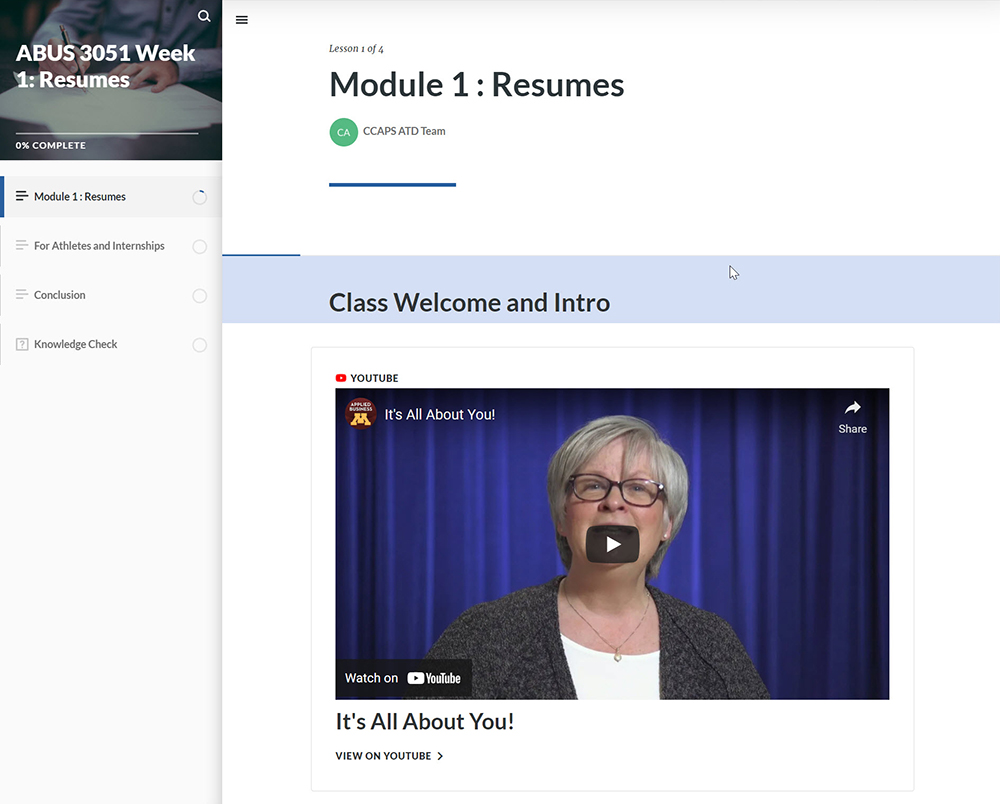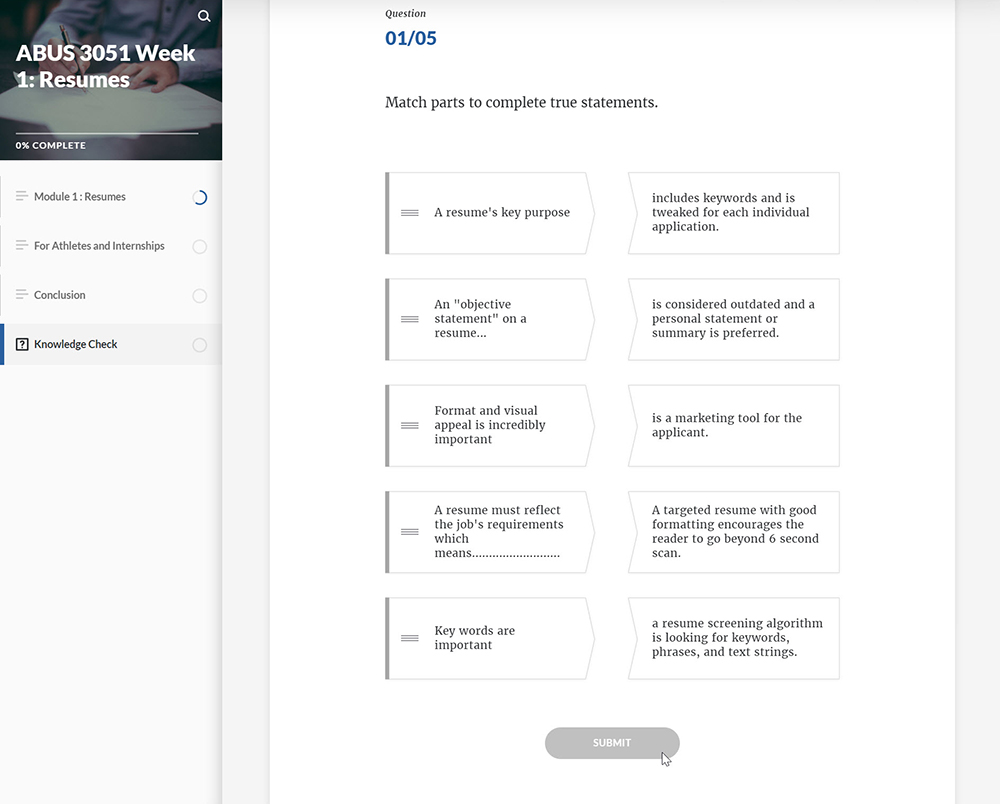Carol Klempka and Jeannine Kessler
During the Summer of 2021, Carol Klempka came to ATD with the question: “How can we integrate Articulate Rise 360 modules into my ABUS courses with a professional account?” Not having any Articulate Rise 360 modules in CCAPS courses so far, we worked to integrate the course modules she created. What we discovered, during the creation process as well as the final delivery, is a tool which has a lot of potential for giving online students a great, new way of delivering course content to them.
Software
Articulate Rise 360 is a cloud based online course authoring tool. It affords the ability to create course modules easily and intuitively. You can break the modules into chapters (or lessons as they are named in the software) and student progress in each lesson is tracked. Each lesson can contain various forms of text, lists, images, audio files, and video. Many of the lessons can include more interaction with tabs, labeled galleries, flashcard grids, process slides, scenario slides and even interactive quiz questions or knowledge checks. One of the most powerful elements is that these modules can be easily integrated into Canvas either as a resource link or integrated into an assignment. The assignments can either become a graded module by just going through it or points can be based on the cumulative knowledge check results. The conditions for how points are brought over into the Canvas course can be easily changed in the Articulate Rise 360 software. As a note, this software is not a replacement for Canvas, but something that can be added to your Canvas course site.
“[Rise 360] is able to display information in a less “clunky” manner than PowerPoints. It’s more fluid and flexible while allowing for students to be more self-directed.” - Carol Klempka
We have an example course, Kaltura Videos in Canvas, that you can review to see what an Articulate Rise 360 Module looks like.
Genesis
“I was intrigued by Articulate Rise 360, through my experience with it used in employee trainings I could see its application in online courses as an efficient and effective method of delivering course content in an appealing way. I wanted to engage the learner, and this program seemed to easily integrate into an engaging learning process.”
Carol first used these Rise 360 modules in ABUS 3051: Career Search for the Professional Environment and ABUS 4105: Becoming an Authentic Leader in the Fall of 2020 with her own account. The results were very positive for the students. “I found it to be an intuitive program for the instructional designer and end user. When the students began receiving course content for the Career Search for the Professional Environment in Rise 360, I noticed how much more the students were absorbing the information. This was reflected in performance improvement on their assignments. Though I had posted the same material on Canvas in the weekly module ‘study notes' documents, these were largely ignored. Once I added the Rise lessons, students were using course terminology and concepts in their discussion posts and assignment submissions. When we changed the Becoming an Authentic Leader course from a 14-week to a 7-week course, I really ramped up those Articulate lessons to be even more robust, linking in expert videos, podcasts and articles. The Rise lessons complement and expand on the course textbooks and clarify the content.”
For the asynchronous classes she teaches, students also began to reach out to Carol more, “I’ve noticed that students started contacting me more frequently but for reasons other than that they were sick or asking for an extended due date on an assignment. Now, they are more curious about applying the course concepts to their personal or work lives. I believe they are grasping the concepts because they are completing the lessons, which is igniting interest and they are considering applications.” One benefit of the Rise modules is the way that knowledge checks can be integrated. ”I use low stake, formative quizzes to help students review the course concepts, or insert more substantial, summative quizzes at the end of the week’s lessons. This gives the students agency to review the material and test their comprehension. But additionally, it highlights the material, so it is top-of-mind before the students begin the course assignment or discussion for that week.”
Spreading Interest
Articulate Rise 360 even appealed to Jeannine Kessler, the Program Director of the Applied Business Program, for her own course: ABUS 4571W: Introduction to Grant Writing for Healthcare and Nonprofit Organizations. When Carol brought her modules to Jeannine’s attention, she taught her how to use the software and create her own modules. Jeannine stated her experience with Rise 360: “It touches all of the senses… Easy to use and add external resources. You can have audio. You can have videos. It has a good flow to it.”
“There is more structure and more flexibility than with a PowerPoint. It’s newer technology. This is the technology students are used to seeing in other places. You can throw in a graph they can touch and feel… PowerPoint on the other hand feels a little bit archaic where it is very lecture driven and static.” - Jeannine Kessler
Rise 360 was first used in Jeannine’s Grant Writing course in the Fall of 2021. Jeannine said that students were saying the modules added a “More up-to-date feel to the courses… It’s easy to follow. Much more contemporary… This is especially more important for the [7-week] courses because you still have to cover the same amount of information, just in a shorter time. Having a way of displaying information in an easy to follow manner is important in courses that need to be more succinct.”
The Future
When I asked Jeannine if she could see Articulate Rise 360 being used in more courses in the Applied Business Program, the answer was a resounding yes. “We would like to bring these into a few more classes but I’d like to do these slowly because it is different and have them understand what we are doing and make sure we have the resources to train them carefully.”
In regards to specific courses: “There are two courses that I know for sure that these would be good for, courses that have to do with graphic design and digital marketing. Those would be excellent classes to bring into this format because, especially in a digital marketing class, we want to make sure we are showing students what can really happen in the world. We are beyond PowerPoints. To have something that is more robust would definitely be more helpful to [students].”
As a final tip to anyone wanting to create these Rise 360 modules for your course, it is best to ensure you know how you want them to fit into the context of each module and that the modules map well to the outcomes of the Canvas module. Also, since the tool offers so much in terms of the type of media that can be used, be mindful to provide those materials so students are not just reading but they are also hearing, watching, and interacting with the information in a way that keeps them engaged. Regarding student learning styles, Carol commented: “To relate to multiple learning styles, I used to attempt to deliver course content in Canvas in various methods. With Rise 360 I can enhance the learning options to provide more responsive and cohesive presentations where concept-relevant videos, audios or links can be embedded at the point-of-learning. This can best address students’ unique learning modalities per topic and eliminate the Canvas “scroll of death” where students seek out the posted links to material in the pages of the course modules. Material placement in a Canvas course might make sense to the instructor, but not to the learner. In a Rise lesson, visual, auditory, and interactive options can be available as part of the presentation and chosen by students according to their learning modality preferences.”
A concern that Carol brought up with using Articulate Rise 360 lessons is that they could easily turn into a “dumping ground” of information: “You have to choose carefully what material you will include. The intention is to provide concise, clarifying information that will engage the learner. Certainly, you can add links to helpful references or resources, but there can be a temptation to share all your knowledge at length. That defeats the purpose. Rise 360 lessons should be designed to reflect the attention span of a normal person… the goal is to connect textbook concepts and course content and make them relatable to the learner. Again, to be concise is the key factor. We’re trying to make [the Rise modules] more relevant to the student, more learner-centric and engaging. Rise lessons are great course tools for scaffolding content, incorporating current events, integrating prior knowledge, and providing micro lessons of usable information for increased comprehension.”
If you are interested in using Articulate Rise 360 in your course or if you have any more questions we welcome CCAPS faculty to reach out to us through the CCAPS-ATD Service Request form.










